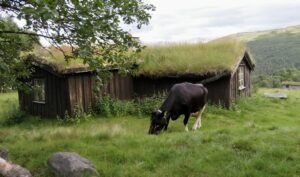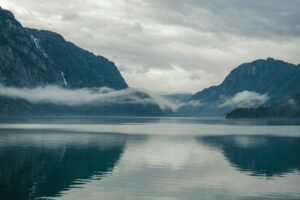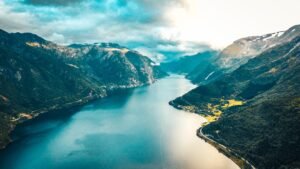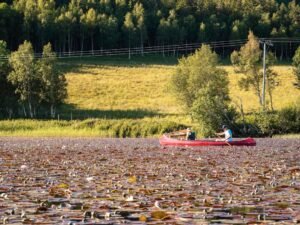
Exploring Creatures in Norse Mythology Guide
Welcome to our comprehensive guide on creatures in Norse mythology! Have you ever wondered about the mythical beings and creatures that populate the fascinating world of Norse folklore? From powerful divine creatures to mysterious beings of the underworld, Norse mythology is replete with a myriad of captivating characters and stories. Join us as we delve into the depths of this ancient mythology and uncover the legends and mysteries behind these incredible creatures.
Table of Contents
ToggleKey Takeaways:
- Discover the diverse range of creatures in Norse mythology, including divine beings, mythical creatures of nature, and legendary beings from folklore.
- Gain an overview of Norse mythology, including the gods, realms, and cosmology that form the backdrop for the existence of these creatures.
- Explore the roles of these creatures in the lives of renowned Norse heroes and their impact on epic sagas.
- Journey into the underworld and encounter dark and eerie creatures that reside there.
- Uncover the legends and stories behind creatures such as trolls, elves, dwarves, and more.
Norse Mythology: An Overview
Before we delve into the enchanting world of creatures in Norse mythology, it is essential to gain a basic understanding of Norse mythology as a whole. This ancient belief system originated in the Nordic regions, and it continues to captivate people’s imagination with its rich lore and fascinating characters.
Norse mythology is centered around a pantheon of gods and goddesses known as the Aesir and Vanir. These divine beings occupy different realms and possess unique attributes and powers. The primary gods among the Aesir include Odin, the Allfather; Thor, the mighty god of thunder; and Loki, the cunning trickster.
In addition to the gods, Norse mythology also encompasses various realms that make up the cosmology of this ancient belief system. These realms include Asgard, the realm of the gods; Midgard, the realm of humans; and Jotunheim, the realm of the giants.
The Norse pantheon is intricately connected to the existence of mythical creatures, beings, and entities that inhabit these realms. These creatures play significant roles in Norse folklore, often serving as allies, enemies, or agents of gods and humans in various tales and legends.
To provide a comprehensive overview, here is a summarized table showcasing some of the key aspects of Norse mythology:
| Realm | Key Gods | Mythical Creatures |
|---|---|---|
| Asgard | Odin, Thor, Loki | Valkyries, Frost Giants |
| Midgard | None | Humans, Dwarves, Animals |
| Jotunheim | None | Giant Serpent Jormungandr, Ice Giants |
This table represents just a glimpse of the vast and intricate interconnectedness within Norse mythology. The stories and legends associated with creatures in Norse mythology are as diverse as the realms they inhabit. From the awe-inspiring Valkyries to the menacing Frost Giants, these creatures bring depth and excitement to the mythological narrative.
In the following sections, we will explore specific aspects of Norse mythology in greater detail, including divine creatures, mythical beings in nature, creatures of the underworld, and their connections to legendary heroes. Stay tuned as we uncover the hidden wonders of Norse mythology and the remarkable creatures that populate its vibrant tapestry.
Aesir and Vanir: Divine Creatures
Dive into the captivating realm of the Aesir and Vanir, the powerful divine creatures in Norse mythology. These legendary beings embody the essence of Norse mythological beings and play significant roles in the ancient stories passed down through generations.
The Aesir and Vanir are two distinct clans of deities, each with their own unique attributes and domains. The Aesir, led by the mighty god Odin, embody the forces of war, wisdom, and kingship. They are known for their exceptional strength, courage, and strategic prowess.
The Vanir, on the other hand, are associated with fertility, prosperity, and nature. Freyr, the god of fertility, and Freyja, the goddess of love and beauty, are prominent figures among the Vanir. These divine beings bring abundance and joy to their worshippers and are often associated with the bounties of the earth.
One of the most famous tales involving the Aesir and Vanir is the Great War, where the two clans clashed before eventually merging and achieving a fragile peace. This event marked the integration of their powers and wisdom, forming a unified pantheon that presided over the Norse cosmos.
Another remarkable story is the tale of Thor, the god of thunder and a member of the Aesir. Beloved among mortals, Thor wields the mighty hammer Mjölnir and stands as a protector against the ancient creatures of chaos and destruction.
To fully understand the complexities of the Aesir and Vanir, let’s explore their key deities and their roles:
Aesir:
- Odin: The Allfather, ruler of the Aesir and god of wisdom, war, and magic.
- Thor: God of thunder, protector of mankind, and defender against ancient creatures.
- Tyr: God of law and justice, known for his courage and self-sacrifice.
- Baldur: God of light, beauty, and purity.
Vanir:
- Freyr: God of fertility, prosperity, and the harvest.
- Freyja: Goddess of love, beauty, and magic.
- Njord: God of the sea, wind, and prosperity.
- Idun: Goddess of eternal youth and guardian of the sacred apples of immortality.
These divine creatures in Norse mythology often interact with humans, forging alliances, granting boons, and challenging mortals through trials and quests. Their stories serve as profound lessons, showcasing the inherent powers and vulnerabilities of both gods and humans.
As we delve deeper into the world of Norse mythology, we will encounter more fascinating divine creatures and their tales, unraveling the intricate web that connects gods to mortals and the cosmic fabric that binds this mythical realm.
Norse Mythical Creatures in Nature
As we delve deeper into the captivating world of Norse mythology, we encounter a fascinating array of mythical creatures that are intricately intertwined with nature. These creatures are not just mere figments of imagination but hold pivotal roles in Norse folklore. Let us explore some of the most noteworthy creatures associated with the natural realm in Norse mythology.
Jormungandr: The Monstrous Serpent
One of the most feared creatures in Norse mythology is Jormungandr, also known as the Midgard Serpent. This enormous sea serpent, child of the trickster god Loki, encircles the entire world, biting its own tail. Said to be able to wrap around the Earth, Jormungandr represents the untamed forces of nature and the constant threat they pose to the gods and humans.
The Unicorns of the Forest
In the lush woodlands of Norse mythology, majestic unicorns can be found. These magnificent creatures boast a single, spiraled horn on their forehead and are known for their grace, purity, and healing powers. With their connection to nature and the spiritual realm, unicorns have both mystical allure and protective qualities.
The Cursed Elf: Nidhogg
Within the Yggdrasil, the cosmic tree that binds the nine realms of Norse mythology, lurks Nidhogg. This horrifying creature is an undead dragon-like being that gnaws tirelessly at the roots of Yggdrasil, seeking to undermine its stability and bring chaos to the natural order. Nidhogg symbolizes decay and destruction, ever striving to upset the delicate balance of the world.
The Elusive Landvættir
Amidst the rugged landscapes of ancient Scandinavia, the Landvættir roam. These nature spirits are said to embody the land itself, taking the form of animals, trees, or elements. Landvættir safeguard their respective territories and are believed to hold tremendous power, influencing the fertility and well-being of the land. They serve as a reminder of the deep connection between humans and the natural world in Norse mythology.
These are just a few examples of the mythical creatures deeply intertwined with nature in Norse mythology. Each creature brings its own symbolism and significance to the rich tapestry of Norse folklore, reflecting the awe and reverence ancient Norse societies held for the natural world.
| Mythical Creature | Symbolism |
|---|---|
| Jormungandr: The Midgard Serpent | Representing untamed nature and ever-present threat |
| Unicorns of the Forest | Symbolizing grace, purity, and healing powers |
| Nidhogg | Embodying decay, destruction, and chaos |
| Landvættir | Guarding the land and influencing its fertility |
Beings of Norse Folklore
Norse folklore is teeming with a diverse array of fascinating creatures and beings that have captivated the imaginations of both ancient and modern audiences. These legendary entities are an integral part of Norse mythology, playing significant roles in the tales and sagas passed down through generations.
One such fascinating creature is the troll, a legendary being known for its immense strength and often depicted as living in isolated areas. Trolls are notorious for causing mischief and disruption, and their presence in Norse mythology adds an element of mystery and intrigue to the stories.
Another iconic creature in Norse folklore is the elf. Often associated with natural beauty and wisdom, elves are believed to be supernatural beings with magical abilities. They are revered for their craftsmanship and are known to reside in enchanted forests or hidden realms.
“The elves, according to Norse mythology, were considered the guardians of nature and possessed great knowledge and artistic skills.” – Source
Dwarves are prominent figures in Norse mythology, known for their exceptional craftsmanship in crafting intricate and valuable objects. They are often portrayed as skilled blacksmiths and miners, crafting legendary weapons and treasures.
Yggdrasil, the mythical World Tree in Norse mythology, is said to connect the different realms of existence. It is believed that various creatures inhabit this sacred tree, including a variety of beings such as dragons, spirits, and other mystical creatures.
The Norns
The Norns, often depicted as three female figures, are pivotal beings in Norse mythology. They are the weavers of fate, responsible for shaping the destinies of both gods and mortals. These powerful entities reside beneath the roots of Yggdrasil and influence the course of events in the mythological world.
These are just a few examples of the legendary beings that populate the rich tapestry of Norse folklore and mythology. Each creature possesses its own unique qualities and significance within the stories and traditions, captivating audiences with their awe-inspiring tales of both heroism and treachery.
As we delve deeper into the enchanting world of Norse folklore, we will continue to uncover more legendary beings and delve into the rich stories and traditions surrounding them.
Creatures of the Underworld
In Norse mythology, the realm of the underworld is a place shrouded in darkness and inhabited by a variety of mysterious creatures. These ancient beings play significant roles in the Norse mythological stories, adding an element of fear and intrigue.
Ferocious Giants:
The underworld is home to ferocious giants, towering in size and strength. These giants, known as Jotnar or Jotuns, are formidable creatures with immense power. They are often depicted as adversaries of the gods and heroes, engaging in epic battles that shape the destiny of the Norse cosmos.
Monstrous Beasts:
In addition to giants, the underworld is populated by monstrous beasts that inspire terror. These creatures strike fear into the hearts of all who encounter them. The monstrous wolf Fenrir, with his insatiable hunger for destruction, and the monstrous serpent Jormungandr, capable of wrapping himself around the entire world, are just a couple of the fearsome creatures that roam the depths of the underworld.
The Enigmatic Hel:
At the heart of the underworld resides Hel, the enigmatic ruler of the realm of the dead. Hel is neither fully alive nor completely dead, embodying the blurred boundary between life and death. She governs over the souls of those who have passed away, determining their eternal fate. Hel is a combination of beauty and darkness, a complex figure who holds immense power over the realm underneath the surface of the living world.
| Underworld Creatures | Description |
|---|---|
| Jotnar or Jotuns | Ferocious giants who often oppose gods and heroes. |
| Fenrir | A monstrous wolf with insatiable hunger and immense strength. |
| Jormungandr | A gargantuan serpent capable of encircling the entire world. |
| Hel | The enigmatic ruler of the realm of the dead, governing over souls. |
These creatures of the underworld in Norse mythology add depth to the intricate tapestry of Norse mythology. They represent the forces of darkness, challenge the might of the divine, and evoke both fear and fascination in those who explore the rich tales of Norse cosmology.
Norse Mythical Creatures and Heroes
Embark on a journey through the extraordinary tales of legendary Norse heroes and the mythical creatures they encounter on their quests and adventures. Within the rich tapestry of Norse mythology, these heroes navigate a world teeming with ancient creatures and beings of immense power.
From the valiant Thor battling fearsome giants like Jormungandr, the monstrous serpent, to Odin’s encounters with mystical beings such as the mighty Fenrir, there are numerous instances where heroes must confront and overcome these formidable mythological creatures.
One such hero is Sigurd, a renowned figure in Norse mythology. In the epic poem, “The Lay of Sigurd,” Sigurd embarks on a perilous journey to slay the fearsome dragon Fafnir. This heroic feat unveils the interconnectedness between heroes and creatures in Norse tales, where their fates often intertwine.
Odin and Sleipnir – A Legendary Bond
Odin, the Allfather, is no stranger to forging unique connections with mythical creatures. One remarkable example is his deep bond with Sleipnir, an eight-legged horse. As the ruler of Asgard, Odin rides Sleipnir across the nine realms, fostering a strong partnership and exemplifying the extraordinary relationships heroes can form with mythological beings.
“Odin and Sleipnir’s bond transcends the ordinary, symbolizing the unity between gods and creatures, as well as the reliance of heroes on these mythical allies in their quests.” – sagastalker
In Norse sagas and legends, heroes often seek the wisdom and assistance of unusual creatures to accomplish their goals. Whether it be the guidance of the wise and mysterious Norns, or the mystical powers of the shape-shifting Loki, these creatures play pivotal roles in shaping the destinies of heroes.
The Nine Realms Chart
| Realm | Mythical Creatures | Associated Heroes |
|---|---|---|
| Asgard | Einherjar (fallen heroes), Valkyries | Odin, Thor, Freyja |
| Jotunheim | Frost Giants | Thor, Loki |
| Midgard | Humans, Dwarves, Trolls | Sigurd, Beowulf |
| Alfheim | Light Elves | Freyja |
| Svartalfheim | Dark Elves, Dwarves | Loki |
| Vanaheim | Vanir gods and goddesses | Freyr, Njord |
| Nidavellir | Dwarves | Loki |
| Niflheim | Icy beings | Hel |
| Muspelheim | Fire giants | Surt |
Explore the intricate web of connections between mythical creatures and heroes in the enthralling sagas of Norse mythology. Witness the influence of these ancient creatures on the lives and destinies of renowned heroes, as they face epic challenges intertwined with the rich tapestry of Norse folklore.
Conclusion
In conclusion, the world of creatures in Norse mythology is a captivating and diverse realm filled with fascinating characters and enchanting tales. The ancient Norse mythological beings, including divine creatures, mythical creatures, and beings from folklore, have left an indelible mark on the rich tapestry of Norse mythology. Exploring the realms of Asgard and the Norse pantheon, we have uncovered the stories of the Aesir and Vanir, powerful gods and goddesses central to Norse mythology.
Furthermore, we have delved into the natural world, where fearsome serpents, majestic unicorns, and other mythical creatures roam. Norse folklore has also introduced us to trolls, elves, and dwarves, beings who have become legendary figures in their own right. The journey extended to the enigmatic underworld, inhabited by dark and mysterious creatures, including giants and the formidable ruler of the realm, Hel.
Throughout the sagas and legends, we have witnessed the enthralling encounters between heroes and these ancient creatures. These mythological beings have served both as adversaries and allies, shaping the fate of brave warriors and leaving an everlasting impact on the Norse heroic tradition.
To truly appreciate the depth and wonder of Norse mythology, one must continue exploring the captivating world of creatures in Norse mythology. Uncover the untold stories, discover new characters, and immerse yourself in the extraordinary realms of these divine, mythical, and folkloric beings. Norse mythology is a treasure trove of wonder and inspiration, providing endless opportunities to delve into the realms of gods and monsters.
FAQ
What are creatures in Norse mythology?
What are some examples of Norse mythological beings?
How do these creatures relate to Norse folklore?
Are there any legendary beings specific to Norse mythology?
What is the significance of these creatures in Norse mythology?
Are these creatures still relevant in modern culture?
If you want to learn Norwegian, you can register for classes here. We look forward to hearing from you and helping you become fluent in Norwegian.





